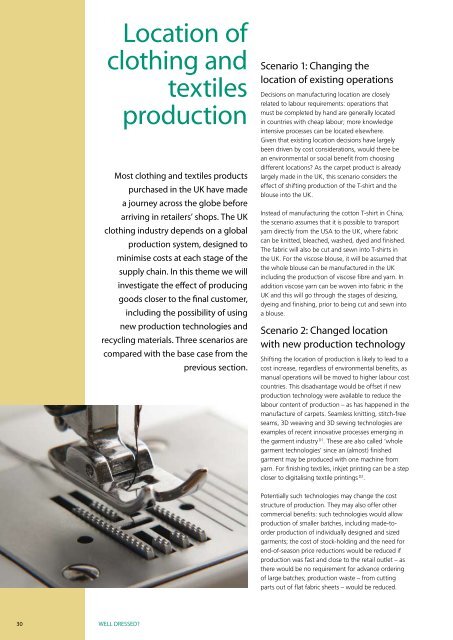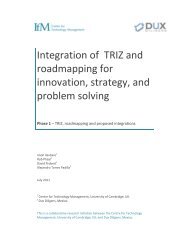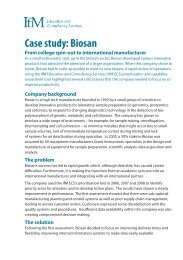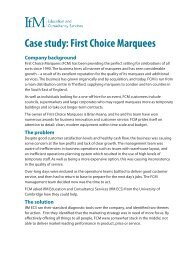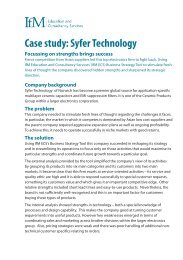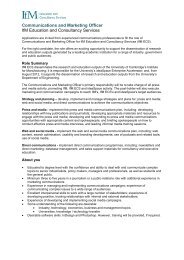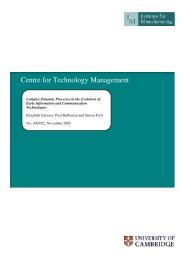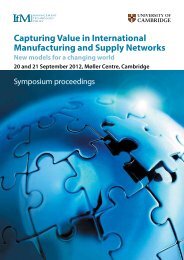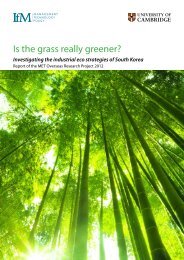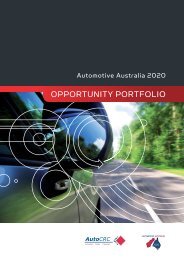The present and future sustainability of clothing and textiles in the ...
The present and future sustainability of clothing and textiles in the ...
The present and future sustainability of clothing and textiles in the ...
Create successful ePaper yourself
Turn your PDF publications into a flip-book with our unique Google optimized e-Paper software.
Location <strong>of</strong><br />
<strong>cloth<strong>in</strong>g</strong> <strong>and</strong><br />
<strong>textiles</strong><br />
production<br />
Most <strong>cloth<strong>in</strong>g</strong> <strong>and</strong> <strong>textiles</strong> products<br />
purchased <strong>in</strong> <strong>the</strong> UK have made<br />
a journey across <strong>the</strong> globe before<br />
arriv<strong>in</strong>g <strong>in</strong> retailers’ shops. <strong>The</strong> UK<br />
<strong>cloth<strong>in</strong>g</strong> <strong>in</strong>dustry depends on a global<br />
production system, designed to<br />
m<strong>in</strong>imise costs at each stage <strong>of</strong> <strong>the</strong><br />
supply cha<strong>in</strong>. In this <strong>the</strong>me we will<br />
<strong>in</strong>vestigate <strong>the</strong> effect <strong>of</strong> produc<strong>in</strong>g<br />
goods closer to <strong>the</strong> f<strong>in</strong>al customer,<br />
<strong>in</strong>clud<strong>in</strong>g <strong>the</strong> possibility <strong>of</strong> us<strong>in</strong>g<br />
new production technologies <strong>and</strong><br />
recycl<strong>in</strong>g materials. Three scenarios are<br />
compared with <strong>the</strong> base case from <strong>the</strong><br />
previous section.<br />
Scenario 1: Chang<strong>in</strong>g <strong>the</strong><br />
location <strong>of</strong> exist<strong>in</strong>g operations<br />
Decisions on manufactur<strong>in</strong>g location are closely<br />
related to labour requirements: operations that<br />
must be completed by h<strong>and</strong> are generally located<br />
<strong>in</strong> countries with cheap labour; more knowledge<br />
<strong>in</strong>tensive processes can be located elsewhere.<br />
Given that exist<strong>in</strong>g location decisions have largely<br />
been driven by cost considerations, would <strong>the</strong>re be<br />
an environmental or social benefit from choos<strong>in</strong>g<br />
different locations? As <strong>the</strong> carpet product is already<br />
largely made <strong>in</strong> <strong>the</strong> UK, this scenario considers <strong>the</strong><br />
effect <strong>of</strong> shift<strong>in</strong>g production <strong>of</strong> <strong>the</strong> T-shirt <strong>and</strong> <strong>the</strong><br />
blouse <strong>in</strong>to <strong>the</strong> UK.<br />
Instead <strong>of</strong> manufactur<strong>in</strong>g <strong>the</strong> cotton T-shirt <strong>in</strong> Ch<strong>in</strong>a,<br />
<strong>the</strong> scenario assumes that it is possible to transport<br />
yarn directly from <strong>the</strong> USA to <strong>the</strong> UK, where fabric<br />
can be knitted, bleached, washed, dyed <strong>and</strong> f<strong>in</strong>ished.<br />
<strong>The</strong> fabric will also be cut <strong>and</strong> sewn <strong>in</strong>to T-shirts <strong>in</strong><br />
<strong>the</strong> UK. For <strong>the</strong> viscose blouse, it will be assumed that<br />
<strong>the</strong> whole blouse can be manufactured <strong>in</strong> <strong>the</strong> UK<br />
<strong>in</strong>clud<strong>in</strong>g <strong>the</strong> production <strong>of</strong> viscose fibre <strong>and</strong> yarn. In<br />
addition viscose yarn can be woven <strong>in</strong>to fabric <strong>in</strong> <strong>the</strong><br />
UK <strong>and</strong> this will go through <strong>the</strong> stages <strong>of</strong> desiz<strong>in</strong>g,<br />
dye<strong>in</strong>g <strong>and</strong> f<strong>in</strong>ish<strong>in</strong>g, prior to be<strong>in</strong>g cut <strong>and</strong> sewn <strong>in</strong>to<br />
a blouse.<br />
Scenario 2: Changed location<br />
with new production technology<br />
Shift<strong>in</strong>g <strong>the</strong> location <strong>of</strong> production is likely to lead to a<br />
cost <strong>in</strong>crease, regardless <strong>of</strong> environmental benefits, as<br />
manual operations will be moved to higher labour cost<br />
countries. This disadvantage would be <strong>of</strong>fset if new<br />
production technology were available to reduce <strong>the</strong><br />
labour content <strong>of</strong> production – as has happened <strong>in</strong> <strong>the</strong><br />
manufacture <strong>of</strong> carpets. Seamless knitt<strong>in</strong>g, stitch-free<br />
seams, 3D weav<strong>in</strong>g <strong>and</strong> 3D sew<strong>in</strong>g technologies are<br />
examples <strong>of</strong> recent <strong>in</strong>novative processes emerg<strong>in</strong>g <strong>in</strong><br />
<strong>the</strong> garment <strong>in</strong>dustry D1 . <strong>The</strong>se are also called ‘whole<br />
garment technologies’ s<strong>in</strong>ce an (almost) f<strong>in</strong>ished<br />
garment may be produced with one mach<strong>in</strong>e from<br />
yarn. For f<strong>in</strong>ish<strong>in</strong>g <strong>textiles</strong>, <strong>in</strong>kjet pr<strong>in</strong>t<strong>in</strong>g can be a step<br />
closer to digitalis<strong>in</strong>g textile pr<strong>in</strong>t<strong>in</strong>gs D2 .<br />
Potentially such technologies may change <strong>the</strong> cost<br />
structure <strong>of</strong> production. <strong>The</strong>y may also <strong>of</strong>fer o<strong>the</strong>r<br />
commercial benefits: such technologies would allow<br />
production <strong>of</strong> smaller batches, <strong>in</strong>clud<strong>in</strong>g made-toorder<br />
production <strong>of</strong> <strong>in</strong>dividually designed <strong>and</strong> sized<br />
garments; <strong>the</strong> cost <strong>of</strong> stock-hold<strong>in</strong>g <strong>and</strong> <strong>the</strong> need for<br />
end-<strong>of</strong>-season price reductions would be reduced if<br />
production was fast <strong>and</strong> close to <strong>the</strong> retail outlet – as<br />
<strong>the</strong>re would be no requirement for advance order<strong>in</strong>g<br />
<strong>of</strong> large batches; production waste – from cutt<strong>in</strong>g<br />
parts out <strong>of</strong> flat fabric sheets – would be reduced.<br />
30 WELL DRESSED?


